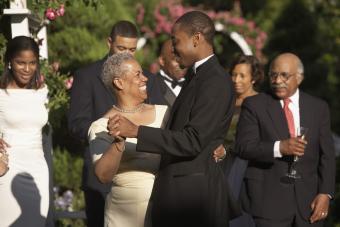
Bolero dance is a slow, sensuous rhythm dance coming from the Spanish tradition. The lead in the dance literally mimics the movements of the toreador in a bullfight, while the follow alternates between movements suggesting the bull or the matador's cape.
The Style of Bolero Dance
Bolero originated in Spain, and has several unique aspects. The dance was believed to have developed in the 18th century and danced to guitar and castanets; Sebastiano Carezo is credited with the original Spanish Dance. A similar dance style appeared in Cuba, and different dance forms developed. While there is some controversy over specific orgifins of the dance, it has a distinctly Latin heritage and several defining features.
Five Parts of Bolero
Bolero dance was given five specific parts:
- Paseo - An introduction of the dancers moving around the dance floor
- Traversa - Literally "crossing" done both before and after the following step.
- Differencias- A series of steps in place displaying the grace and balance of the dancers.
- Finales - Where the dancers interact passing by each other in various ways, lending itself to flirting and connection.
- Bien parado - Literally "graceful attitude," acknowledging the audience as a couple, then with a brief embrace of an arm at the waist, finally formally saluting each other before departing the dance floor.
Drama and Grace
When listed that way, the dance loses some of its intense passionate charge. But, like the bullfights it is modeled after, bolero dance is full of dramatic tension combined with the discipline of athletic grace. The movements are low and sinuous across the floor, with the the dancer's weight usually on the toes.
- Dance Frame - The dance frame (the way the dancers hold their torso during the dance) is held very strong and macho, with graceful up-and-down movement as they glide on the floor.
- Arm Stylings - The arm stylings, however, move into the vertical quite often and are often soft in action. One of the basic flourishes involves both dancers extending their arms in long arcs over their heads, like the waving fabric of a cape as the crowd shouts "Ole!"
- Other Moves - Other moves include intricate footwork designed to suggest the teasing, charging, and avoidance games played by the the matador and his opponent.
Latin Competition and Evolution of Bolero
Bolero became a part of the American dance scene in the 1930s, partially due to Maurice Ravel's very popular composition of the same name. As the world of ballroom dance became more competitive, the dance form was added along with cha cha, east coast swing, rumba, and mambo as one of the rhythm competition dances. It is one of the most difficult because of the slow and highly stylized nature of it. Many people mistake it for a slow rumba, and it's not surprising - the rumba has a standard beat of 104 beats per minute, where bolero dance is only 96, edging out the rumba to be the slowest of the rhythm dances. Some even refer to it as one of three types of rumba. However, the bolero is technically distinct from the rumba in its form and movement.
Bolero Time Signature
The time signature for Bolero is a reflection of its journey across the ocean. Originally danced in ¾ time in Spain (where it is said to be a version of the Flamenco sequidillias or a respectable version of the fandango) it traveled to Cuba and developed there alongside the rumba, moving to 2/4 time. Eventually this evolved into the the 4/4 time that we use in the dance today. There is also a Mexican variant of the Bolero, making it one of the most authentically Latin of the Latin dances.
Demanding Yet Beautiful
It is also, like rumba, danced in a "box" style, with a slow sweeping glide to the side on the first two beats and then two forward steps - one short, one of medium distance - done after to complete the basic step. Because the rise and fall are in the body, not in the feet, the Bolero is a dance that appears effortless but actually is very physically demanding. Because of this, Bolero is not danced socially very much any longer - other dances such as the salsa, the rumba, and Argentinian tango have replaced it in popularity. For those who are more competitive, though, it is a challenging and rewarding performance and a perennial audience favorite.
Beauty of Bolero
One thing that remains undisputed is the beauty of bolero dance. Although its evolution has brought new dimensions to this historic dance, it retains the unique flair of its roots and continues to b a beautiful dance today.







